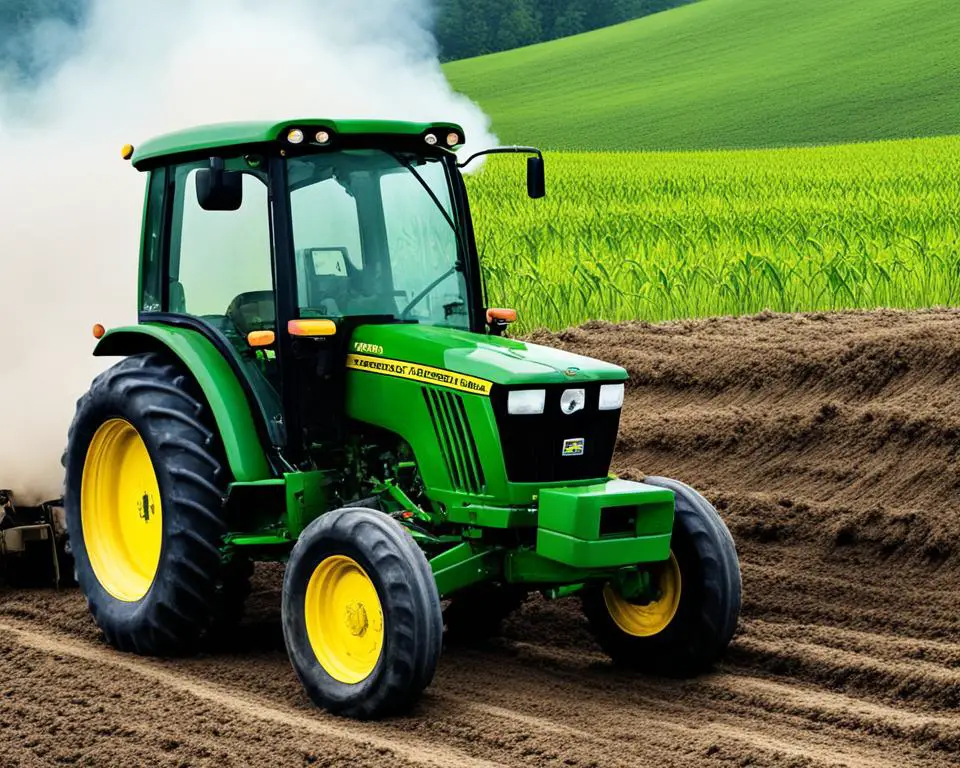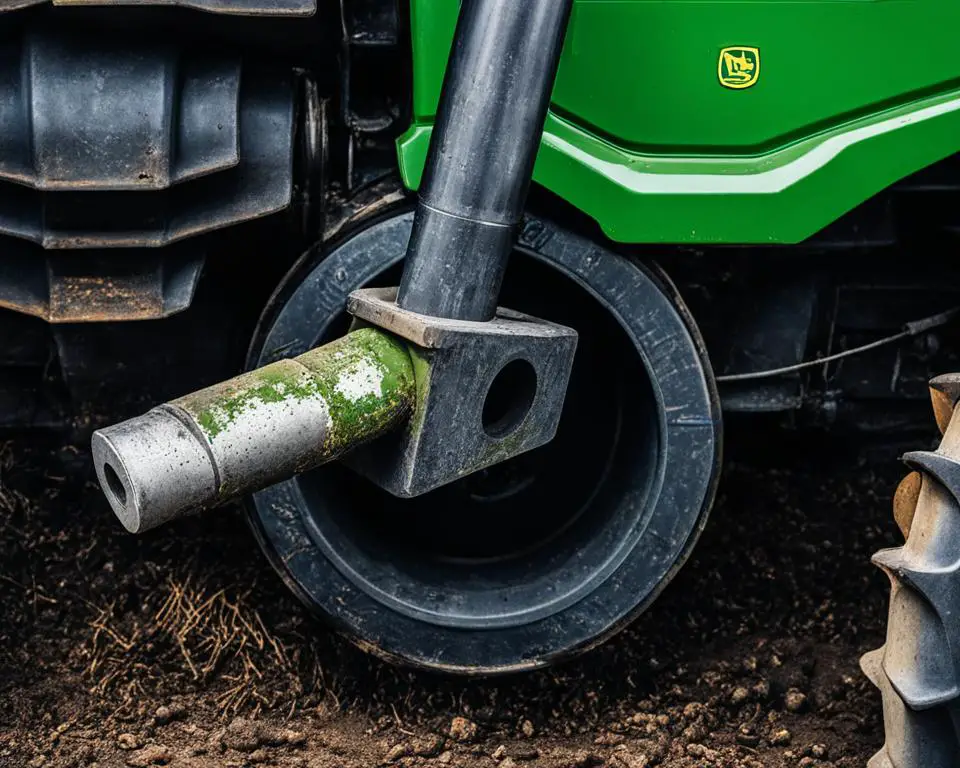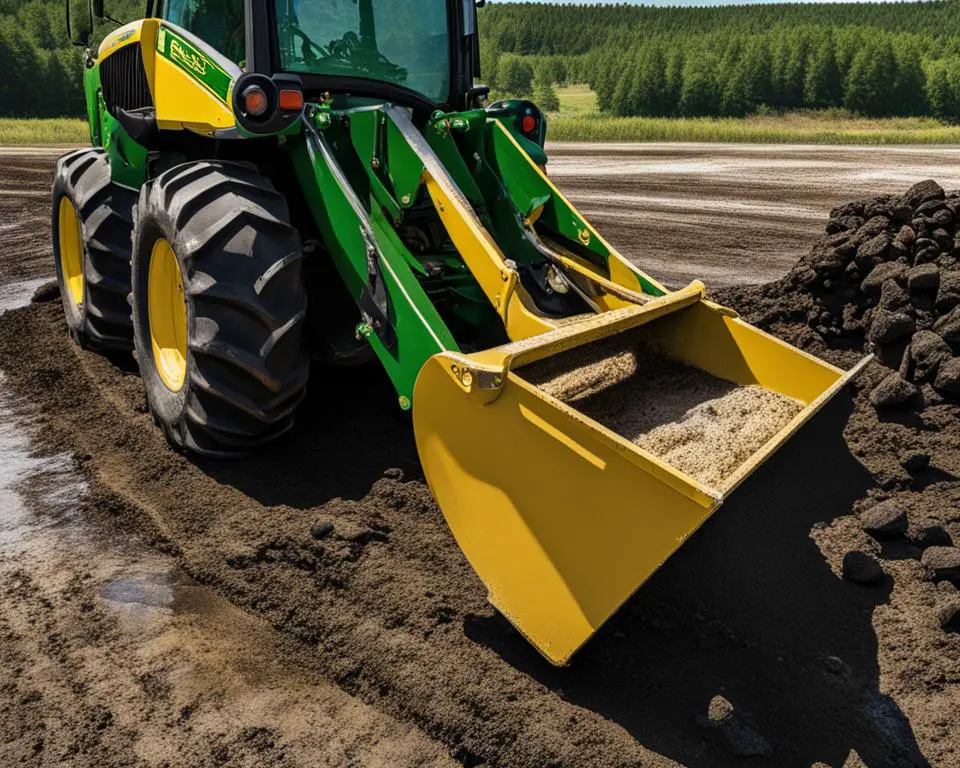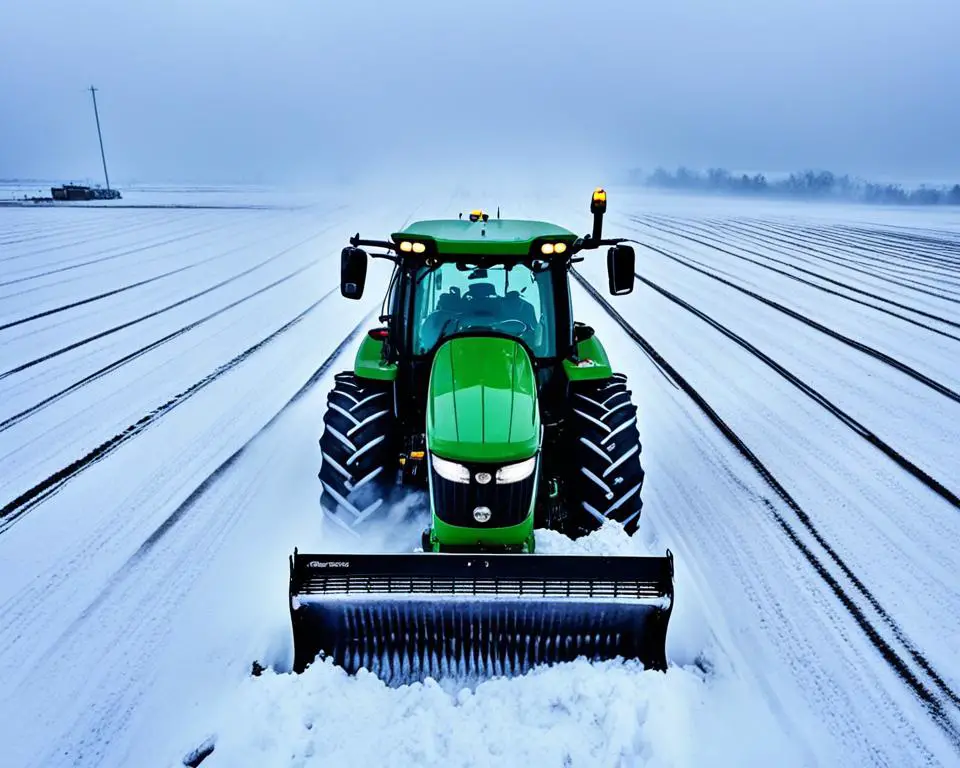If you own or operate a John Deere 2320 compact utility tractor, you may have experienced some common problems that can hinder its performance. But worry not, because in this article we will provide solutions to these issues and help you get the most out of your tractor.
The John Deere 2320 is widely recognized for its capabilities, but like any piece of machinery, it can encounter its fair share of challenges. From poor start to underpowered and noisy transmission, driveshaft U-joint problems to loader bucket and hydraulic issues, ignition switch problems to PTO clutch issues, we’ll cover it all.
But don’t let these problems discourage you. With the right knowledge and troubleshooting techniques, you can keep your John Deere 2320 running smoothly and efficiently. We have gathered valuable insights from experienced users and professionals to provide you with practical solutions.
Join us as we delve into the world of John Deere 2320 problems and explore effective solutions that will help you overcome these common issues. Whether you use your tractor for heavy-duty tasks or everyday chores, our goal is to empower you with the knowledge and resources necessary to optimize its performance.
Poor Start
One of the common problems with the John Deere 2320 is a poor start. This can be frustrating for tractor owners, as it can make it difficult to get the machine up and running when needed. Poor start issues can manifest as difficulties in starting the tractor, such as it turning over but not firing.
When troubleshooting a poor start with the John Deere 2320, there are several potential causes to consider. These include:
- Alternator issues
- Damage to fuses
- Voltage problems with the ignition switch
- Corroded battery connections
- Overheating
Inspecting and addressing these potential problems can help resolve the poor start issue. Start by checking the alternator’s output and making sure it is functioning properly. Damaged fuses should be replaced to ensure proper electrical flow. Voltage problems with the ignition switch may require professional assistance to diagnose and fix. Corroded battery connections can be cleaned or replaced as needed. Finally, overheating can result in poor starting, so check the cooling system and address any issues.
It is important to note that poor start issues may occur intermittently or after a temporary fix. Therefore, it is essential to thoroughly troubleshoot and address any underlying problems to prevent future occurrences.
Troubleshooting Steps:
1. Inspect the alternator: Check the alternator’s output to ensure it is functioning properly.
2. Replace damaged fuses: If any fuses are damaged, replace them to allow for proper electrical flow.
3. Address voltage problems: If there are voltage issues with the ignition switch, seek professional assistance to diagnose and fix the problem.
4. Clean corroded battery connections: Clean or replace corroded battery connections to ensure proper electrical connection.
5. Check the cooling system: Overheating can cause poor starting, so inspect the cooling system and address any issues.
Addressing the common causes of poor start issues in the John Deere 2320 can help owners get their tractor up and running smoothly. By troubleshooting and addressing alternator issues, damaged fuses, voltage problems, corroded battery connections, and overheating, owners can ensure reliable starting performance.”
| Possible Causes | Troubleshooting Steps |
|---|---|
| Alternator issues | Inspect the alternator and check its output. |
| Damage to fuses | Replace any damaged fuses. |
| Voltage problems with the ignition switch | Seek professional assistance to diagnose and fix the problem. |
| Corroded battery connections | Clean or replace corroded battery connections. |
| Overheating | Check the cooling system for any issues. |
John Deere 2320 Underpowered and Noisy Transmission
When it comes to the John Deere 2320, an underpowered and noisy transmission is a common issue that many owners face. The tractor’s hydrostatic transmission can lack the necessary torque, resulting in decreased performance and difficulty in tackling demanding tasks.
One of the primary symptoms of an underpowered transmission is the tractor struggling to maintain consistent power, especially when operating with multiple attachments. Additionally, users often report loud noises coming from the transmission, further indicating a problem.
The root cause of this issue can vary, but one common culprit is toothless reduction gears within the transmission. These worn-out gears can impede the power transmission and create excessive noise during operation. Other possible transmission-related faults can also contribute to the underpowered and noisy nature of the tractor’s performance.
If you’re experiencing an underpowered and noisy transmission with your John Deere 2320, it’s advisable to take it to an authorized dealer for a thorough inspection and repair. A professional technician can diagnose the specific problem and recommend the appropriate steps to address it effectively.

Customer Testimonials
“The underpowered transmission of my John Deere 2320 was a significant concern for me. It struggled to deliver the necessary power for certain tasks, making it challenging to use effectively. Thankfully, taking it to the dealer resolved the issue, and now the tractor performs flawlessly.”
– John Smith, John Deere 2320 Owner
I noticed strange noises coming from the transmission of my John Deere 2320, and it was affecting my overall experience with the tractor. After having it inspected by a professional, the toothless reduction gears were identified as the problem. Replacing them made a world of difference, restoring the tractor’s power and eliminating the noise.”
– Emily Johnson, John Deere 2320 Owner
| Common Symptoms | Possible Causes | Solutions |
|---|---|---|
| Underpowered performance | Worn-out toothless reduction gears | Replace toothless reduction gears |
| Noisy transmission | Transmission-related faults | Inspect and repair transmission |
Driveshaft U-joint Problems
The driveshaft U-joints on the John Deere 2320 can be a source of trouble for owners. These U-joints have a tendency to break, particularly at the grease zerk. If you notice loud or squeaky noises during transmission operation, or experience issues while mowing, it’s likely that the U-joints are at fault.
Fortunately, there is a solution to this problem. Broken U-joints can be replaced with aftermarket parts. There are affordable aftermarket options available for these U-joints, allowing users to replace them with brand new ones using readily available parts from the market.
If you’re encountering driveshaft U-joint problems with your John Deere 2320, it’s essential to address the issue promptly. Failing to do so can lead to further damage to the driveshaft or other components of the tractor’s transmission system.

It’s crucial to invest in quality aftermarket U-joint replacements to ensure the longevity and performance of your John Deere 2320. These parts should be durable and designed to withstand the demands of heavy-duty use. Additionally, following proper installation procedures will help prevent future U-joint problems and ensure the smooth operation of your tractor.
| Benefits of aftermarket U-joint replacements: |
|---|
| 1. Cost-effective solution |
| 2. Availability of market-ready parts |
| 3. Improved durability and performance |
| 4. Easy installation process |
By addressing driveshaft U-joint problems with quality aftermarket replacements, you can ensure a seamless and reliable operation of your John Deere 2320, minimizing downtime and maximizing productivity.
Loader Bucket and Hydraulic Issues
Loader bucket and hydraulic issues are common problems that some owners of the John Deere 2320 compact utility tractor may encounter. These issues can affect the functionality of the bucket and the hydraulic system, leading to difficulties in raising or curling the bucket, as well as problems with fluid levels and connections in the hydraulic system.
One possible solution to address these problems is changing the hydraulic fluid. Over time, hydraulic fluid can become contaminated or degrade, resulting in poor performance. By replacing the old fluid with fresh, high-quality hydraulic fluid, users can improve the operation of the hydraulic system and potentially resolve issues with the loader bucket.
Another area to check is the hydraulic connections. Loose or damaged connections can cause hydraulic leaks and reduce the effectiveness of the system. Inspecting all hydraulic connections and tightening or replacing any that are faulty can help restore proper functioning.
If the issues persist despite these troubleshooting steps, it is recommended to take the tractor to a qualified dealer. Dealers have the expertise to diagnose and repair more complex hydraulic problems, ensuring that the loader bucket and hydraulic system operate optimally.

| Common Loader Bucket and Hydraulic Issues | Possible Solutions |
|---|---|
| Bucket not raising or curling properly | Change hydraulic fluid Check hydraulic connections |
| Fluid level issues in the hydraulic system | Change hydraulic fluid Inspect for leaks Check hydraulic connections |
Ignition Switch Problems
Ignition switch problems are a common issue that John Deere 2320 owners may encounter. These problems can result in difficulties with starter engagement and key turning, making it challenging to start the tractor. Users may experience a click sound instead of the starter engaging, or the starter may only engage after repeatedly turning the key back and forth.
The main cause of these problems is a faulty ignition switch. Over time, the switch can wear out or become damaged, leading to inconsistent electrical connections. When the ignition switch fails to make proper contact, it can disrupt the flow of power to the starter, resulting in starting issues.
To resolve ignition switch problems in the John Deere 2320, it is recommended to disassemble the dash and replace the faulty ignition switch with a new one. Replacing the switch will restore proper electrical connections, ensuring reliable starter engagement and smooth key turning.
| Common Symptoms of Ignition Switch Problems | Solution |
|---|---|
| Click sound instead of starter engagement | Replace the faulty ignition switch |
| Starter engages after multiple key turns | Disassemble the dash and install a new ignition switch |
PTO Clutch Issues
Operating a John Deere 2320 with PTO clutch issues can be frustrating. These problems can result in an underpowered mower deck and difficulties engaging the PTO. Users may notice the PTO light illuminating, but the tractor fails to shut off as if the seat safety switch were broken. Fortunately, there are steps you can take to resolve these issues and get your tractor back in working order.
The first thing to check is the position of the PTO lever. Make sure it is correctly set to engage the PTO. If the lever is not fully engaged, it can cause the deck to be underpowered and result in the PTO not engaging properly. Simply ensuring the lever is in the correct position can often solve this problem.
If adjusting the PTO lever does not resolve the issue, it is important to troubleshoot the seat safety switch. This safety feature is designed to shut off the PTO when the operator leaves the seat to prevent accidents. A malfunctioning seat safety switch can cause the PTO to remain engaged even when the operator is not seated. Check the condition of the seat safety switch and make any necessary repairs or replacements to ensure it is functioning correctly.
By correctly positioning the PTO lever and troubleshooting the seat safety switch, you can effectively address PTO clutch issues on your John Deere 2320 tractor. These steps will help you regain proper PTO operation and ensure a smooth and efficient mowing experience.
FAQ
What are some common problems with the John Deere 2320?
Some common problems with the John Deere 2320 include poor start, underpowered and noisy transmission, driveshaft U-joint problems, loader bucket and hydraulic issues, ignition switch problems, and PTO clutch issues.
How can I resolve a poor start issue with my John Deere 2320?
To resolve a poor start issue, you can try troubleshooting and replacing corroded or damaged parts, cleaning relays, and checking safety settings. Some possible causes of this problem include alternator issues, damaged fuses, voltage problems with the ignition switch, corroded battery connections, and overheating.
What should I do if my John Deere 2320 has an underpowered and noisy transmission?
If your John Deere 2320 has an underpowered and noisy transmission, it is recommended to take the tractor to a dealer for inspection and repair. This issue may be caused by toothless reduction gears or other transmission-related issues.
What can I do to fix driveshaft U-joint problems on my John Deere 2320?
To fix driveshaft U-joint problems, you can replace the broken U-joints with aftermarket parts. Cheap aftermarket parts are available, and users can replace them with brand new U-joints using market-available parts.
How can I resolve loader bucket and hydraulic issues on my John Deere 2320?
To resolve loader bucket and hydraulic issues, you can try changing the hydraulic fluid, fixing hydraulic connections, and taking the tractor to a dealer for further inspection and repair. These issues may cause the bucket to not raise or curl properly and result in problems with the hydraulic system’s fluid levels and connections.
What should I do if my John Deere 2320 has ignition switch problems?
If your John Deere 2320 has ignition switch problems, you can disassemble the dash and replace the faulty ignition switch with a new one. Ignition switch problems can cause starting issues, such as a click instead of the starter engaging or the starter engaging only after turning the key back and forth multiple times.
How can I resolve PTO clutch issues on my John Deere 2320?
To resolve PTO clutch issues, ensure that the PTO lever is in the correct position and troubleshoot the seat safety switch. PTO clutch issues can cause the deck to be underpowered and result in problems with engaging the PTO. Users may experience the PTO light coming on but the tractor not shutting off as if the seat switch were broken.

Leave a Reply